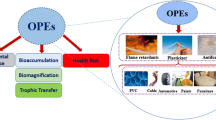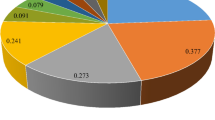Abstract
Persistent organochlorine pollutants (POPs) are analyzed for the dropping-amended soils from the habitats of Antarctic seabirds and seals in Fildes Peninsula and Ardley Island. The concentration ranges are 0.21 to 3.85 ng/g for polychlorinated biphenyls (ΣPCBs), 0.09 to 2.01 ng/g for organochlorine pesticides (ΣDDT), and 0.06 to 0.76 ng/g for hexachlorocyclohexanes (HCHs). Among these, hepatachlorobiphenyls, hexachlorobiphenyls, p,p′-DDE and α-HCH compounds are dominant. The concentration ranges of ΣPCB, DDT and HCH in the eggs of skuas were 91.9–515.5 ng/g, 56.6–304.4 ng/g and 0.5–2.0 ng/g respectively; those in the eggs of penguins were 0.4–0.9 ng/g, 2.4–10.3 ng/g and 0.1–0.4 ng/g; and those in the eggs of giant petrel were 38.1–81.7 ng/g, 12.7–53.7 ng/g and 0.5–1.5 ng/g respectively. The dominant POP compounds in the eggs are PCB180, PCB153, p,p′-DDE and hexachlorobenzene (HCB). The present study shows that the concentration of POPs in the seabird-inhabited-dropping-amended soil varies with the extent of predation and nest occupancy of different seabird populations. Statistical analysis on the POP concentrations from the different seabird eggs implies that the difference in the bio-concentration levels of the birds depends on the bio-habits of the species, such as the range of activity, distance of immigration, feeding pattern, and nest occupation. Among these, the most important factor is the location of the seabirds in the food chain and their feeding pattern. This shows that POPs accumulated in the seabirds resulted from the bio-concentration through the food chain. In addtion, 210Pb dating for the dropping-amended soils (AD1-a and AD2) was performed, which provided the POP accumulation rate and the historic record for the soil profile. It indicates that POP will continuously affect the Antarctic ecosystem for a long time.
Similar content being viewed by others
References
Sladen W J L, Menzic G M, Reichel W L. DDT Residues in Adelic peuguius and a crabeater seal from Antarctica. Nature, 1966, 210: 670–673
Alegria H A. Organochlorine pesticides in ambient air of Belize, Central America. Environ Sci Technol, 2000, 34: 1953–1958
Tanabe S, Hidaka H, Tatsukawa R. PCBs and chlorinated hydrocarbon Pesticides in the Antarctic atmosphere and hydrosphere. Chemosphere, 1983, 12: 277–288
Kawano M, Tanabe S. Biological accumulation of chlordane compounds in marine organisms from the northern North Pacific and Bering Sea. Mar Poll Bull, 1986, 17: 512–516
Focardi S, Fossi C, Lari L, et al. Induction of mixed function oxidase (MFO) system in two species of Antarctic fish from Terra Nova Bay (Ross Sea). Polar Biol, 1992, 12: 721–725
Risebrough R W, WalkerII W, Schmitt T T. Transfer of chlorobiphenyls to Antarctica. Nature, 1976, 264: 1098–1102
Hidaka H, Tanabe S, Tatsukawa R. DDT compounds and PCB isomers and congeners in Weddell seals (Leptonychotes weddelli) from the Antarctic. Chemosphere, 1983, 13: 95–100
Subramanian B A, Tanabe S, Hidaka H, et al. DDTs and PCB isomers and congeners in Antarctic fish, Arch. Environ Contam Toxicol, 1983, 12: 623–626
Luke B G, Johnstone G W, Woehler E J. Organochlorine Pesticides, PCBs, and mercury in Antarctic and subahtarictic seabirds. Chemosphere, 1989, 19: 2007–2021
Odete N K, Inomata O N K, Montone R C, et al. Tissue distribution of Organochlorine residues PCBs and pesticides in Antarctic Penguins. Antarctic Sci, 1996, 8: 256–255
Wang Z P, Peter H U. Specis and distribution of the birds on fides peninsula, king george island, Antarctica, Chin J Polar Res (in Chinese), 2004, 16: 271–280
Dong J H, Wang G J, Feng J. Antarctic PACK ice seal. Chin J Polar Res (in Chinese), 1999, 11: 136–142
Sun L G, Xie Z Q, Zhao J L. A 3000-year record of penguim populations. Nature, 2000, 407: 858
Vetter W, Natzeck C, Luckas B, et al. Chlorinated hydrocarbons in the blubber of a seal (Phoca caspica) from the Caspian Sea. Chemosphere, 1995, 30: 1685–1696
Vetter W, Weichbrodt M, Hummert K. Combined microwave-Assisted extraction and gel permeation chromatography for the determination of chlorinated hydrocarbons in seal blubber and cod Livers. Chemosphere, 1998, 37: 2439–2449
Pu J B, Li Z P, Shao M H, et al. A survey of the env ironmental contamtion state in king george island, Antarctica. Antarctic Research (in Chinese), 1995, 7: 51–58
Monirith I, Ueno D, Takahashi S. Asia-Pacific Mussel Watch: monitoring contamination of persistent organochlorine compounds in coastal water of Asian countries. Mar poll Bull, 2000, 46: 281–300
Jantunen L M, Bidleman T F. Reversal of the air-water gas exchange direction of hexachlorocyhexanes in the Bering and Chukchi Sea: 1993 versus 1988. Environ Sci Technol, 1995, 29: 1081–1089
Marchoff E, Gonzales B, Vivequin S. Studies on krill from penquin stomach contents at Potter Cove. Berichte, 1998, 299: 236–246
Peter H U, Kaiser M, Gebauer A. Ecological and morphological investigations on south polar skuas (Catharacta maccormicki) and brown skuas (Catharacta skua lonnbergi) on Fildes Peninsula, King George Island. South Shetland Islands, Zool Jb Syst, 1999, 117: 201–218
Gonzalez-solis J, Croxall J P, Wood A G. Foraging partitioning between giant petrels Macronectes spp. and its relationship with breeding population changes at Bird Island, South Georgia. Mar Ecol Prog Ser, 2000, 204: 279–288
Casaux R, Barrera-Oro E, Cona N et al. Fish as prey of birds and mammals at the South Shetland Islands. Berichte, 1998, 299: 267–274
Wang Z P, Norman I F. Food of the South Polatr Skua Catharacta maccormicki in the eastern Larsemann Hills, Princess Elizabeth Land, East Antarctica. Polar Biol, 1990, 13: 255–262
Brubaker W W J. OH reaction kineties of gas-phase a-and β-hexachlorocyclohexane and hexachlorobenzene. Environ Sci Technol, 1998, 32: 766–775
Kawano M T, Inoue T, Wada H, et al. Bioconcentration and residue patterns of chlordane compounds in marine animals: invertebrates, fish, mammals, and seabirds. Environ Sci Technol, 1988, 22: 92–797
Hinckley D A, Bidleman T F, Rice C P. Atmospheric organochlorine pollutants and air-sea exchange of hexachlorocyclohexane in the Bering and Chukchi seas. Geophys Res, 1991, 96: 7201–7213
Iwata H, Tanabe S N, et al. Distribution of persistent organochlorine in the oceanic air and serface seawater and the role of ocean on their global transport and fate. Environ Sci Technol, 1993, 27: 1080–1098
Pacyna J M, Oehme M. Long-range transport of some organic compounds to the Norwegian Arctic. Atmos Environ, 1998, 22: 243–257
Klaus-Michael, Exo Peter H B, Sommer U. Organochlorine and mercury concertration in eggs of grey plovers (Pluvialis squatarola) breeding in the Lenad Delta, north-east Siberia, 1997. Polar Research, 2000, 2: 261–265
Buser H R, Müller M D. Isomer and enantioselective degradation of hexachlorocyclohexane isomers in sewage sludge under anaerobic conditions. Environ Sci Technol, 1995, 29: 664–672
Weichbrodt M, Vetter W, Scholz E, et al. Determination of organochlorine levels in antarctic skua and penguin eggs by application of combined focused open-vessel microwave-assisted extraction Gel-permeation chromatography,adsorption chromatography and GC/ECD. Environ Anal Chem, 1999, 73: 309–320
Schneider R, Steinhagen G S, Drescher H E. Antarctic Nutrient Cycles and Food Webs. In: Siegfried W R, Condy P R, Laws R M, eds. Berlin-Heidelberg: Springer Verlag, 1985. 652–655
Marchoff E, Gonzales B, Vivequin S. Studies on krill from penquin stomach contents at Potter Cove. Berichte, 1998, 299: 236–246
Peter H-U, Kaiser M, Gebauer A. (1990): Ecological and morphological investigations on south polar skuas (Catharacta maccormicki) and brown skuas (Catharacta skua lonnbergi) on Fildes Peninsula, King George Island. South Shetland Islands, Zool Jb Syst, 1999, 117: 201–218
Wang Z P, Peter H U. Primary study on using skua as designative species in antarctic environmental monitoring. Chin J Polar Res (in Chinese), 2004, 16: 91–98
Wang Z P, Peter H U. Impacts of station garbage on the diet of antaectic skuas in King George island. Chin J Polar Res (in Chinese), 2003, 15: 177–185
Strachan W M J, Eriksson G, Kylin H, et al. Organochlorines compounds in pine needles: methods and trends. Environ Toxicol Chem, 1994, 13: 443–451
Bidleman T F, Walla M D, Roura R, et al. Organochlorine pesticides in the atmosphere of the southern ocean and Antarctica, January March, 1990. Mar Pollition Bull, 1993, 26: 258–262
Hisato I, Shinsuke T, Mari A, et al. Persistent organochlorine residues in sediments from the Chukchi Sea, Bering Sea and Gulf of Alaska. Mar Poll Bull, 1994, 28: 746–753
Vetter W. Determination of Q1, an unknown organochlorine contaminant, in human milk, Antarctic air and further environmental samples. Environ Poll, 2000, 110: 401–409
Vetter W, Marion W, Elke S. Indication of geographic variations of organochlorine concentrations in theblubber of Antarctic Weddell Seals (Leptonychotes weddelli). Environ Sci Technol, 2003, 5: 840–844
Author information
Authors and Affiliations
Corresponding author
Additional information
Supported by the National Natural Science Foundation of China (Grant Nos. 40576003 and 40276037)
Rights and permissions
About this article
Cite this article
Zhang, H., Wang, Z., Lu, B. et al. Occurrence of organochlorine pollutants in the eggs and dropping-amended soil of Antarctic large animals and its ecological significance. SCI CHINA SER D 50, 1086–1096 (2007). https://doi.org/10.1007/s11430-007-0021-0
Received:
Accepted:
Issue Date:
DOI: https://doi.org/10.1007/s11430-007-0021-0




